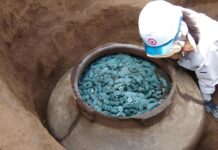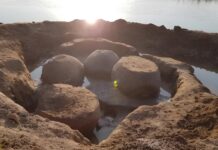The Cantalloc Aqueducts, erected by the Nazca people during Peruvian history’s pre-Columbian period, are still in use, with local farmers relying on them to bring water to the arid region.

A group of scholars led by Rosa Lasaponara of the Institute of Methodologies for Environmental Analysis recently studied satellite images to see whether they revealed any new information about the “puquios” — a network of aqueducts located 4 kilometers (2.5 miles) west of Nazca, Peru. There are approximately 40 such aqueducts in existence, all built by the Nazca culture and used all year.
These structures in Peru’s lowlands are around 2.5 miles (4 kilometers) east of the famous Nazca lines. The structures may have a theme, according to speculations that the lines played a symbolic function in the search for water, which the Nazca aqueducts were supposed to harness. These canals, like the Nazca lines, are assumed to have served a religious function in addition to making the land more suitable to agriculture.

The unearthing of the aqueducts revealed the Nazca civilization’s technological capabilities. The spiral structures, known as ‘puquios,’ were part of a hydraulic system that recovered and channeled water. Wind was able to blow into a network of underground canals, transporting water from underground aquifers to where it was most needed. The puquios were such a success that 30 of them are still in use today by farmers.
A network this extensive and long-lasting reveals its creators’ understanding of the geology and seasonal water supply characteristics of the surrounding region.

Between around 100 BC and 800 AD, the Nazca civilization thrived along Peru’s arid southern coast in the river basins of the Rio Grande de Nazca drainage and the Ica Valley. The Nazca developed a vast range of crafts and technology, including ceramics, textiles, geoglyphs, and, of course, aqueducts, all of which were highly influenced by the preceding Paracas civilisation (famous for its extremely complex textiles).
Aside from these extraordinary water networks, the Nazca people of Peru’s Ica Region are best known for the Nazca Lines, which are huge designs on the desert with no apparent function. The oldest of these lines was just determined to be a fat cat.

The Nazca, like other Coastal Andean peoples in South America, were keen observers of the vast ocean environment. A beautiful example is the whale tooth engraved with a lovely lady below.
The salty ocean and its exotic fauna were a dyadic antithesis to the land’s fresh waters. The carving of a ceremonial sculpture from the teeth of a gigantic sea monster was evidently symbolic.

But let’s get back to the Nasca’s incredible aqueduct systems. They were built to transport water from mountain springs, and the word ‘puquios’ relates to the spiral-shaped beginning points.
These springs, which are often covered with wooden roofs and surrounded by stones, are located rather far up the mountain slopes. Deep ditches transport water from the puquios to lowland fields.

Because the aqueducts are designed in massive bends, the courses are easy to follow. The Nazca avoided flooding by twisting their rivers to keep the water from flowing too quickly when the snow melted in the spring.
These spirals are referred to as ‘ojos,’ which is Spanish for ‘eyes.’ You can really get into them, spiraling down stone steps to the cooling wells at the bottom. Farmers descend from the ‘ojos’ to clean up the canals, whilst the aqueducts require regular upkeep. In exchange, they get a lushly vegetated environment – a cool place to hike with breathtaking mountain views in all directions.

Apart from what has previously been revealed, the only thing we know about the Nazca is their ingenuity in their crafts. As a result, these unique water management systems are a must-see for anybody visiting the Nazca Lines. The Cantalloc Aqueducts show a smart determination to make the desert fit those demands, while the lines represent a rich and imaginative religious life.






